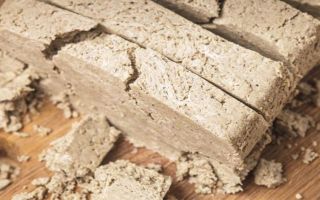Content
- 1 What is tahini halva made of
- 2 Composition and calorie content of sesame halva
- 3 The benefits of sesame halva for the body
- 4 Is it possible to sesame halva
- 5 Recipe for making homemade sesame halva
- 6 Harm of sesame halva and contraindications
- 7 How to choose sesame halva
- 8 Storing sesame halva
- 9 Conclusion
Today there are many types of halva. The benefits and harms of sesame halva, as well as many of its other varieties, depend entirely on the components used in the production process. Among all this variety of delicacies, special attention is paid to tahini halva. This product has not only useful properties, but also unusual taste, rich composition. If necessary, sesame dessert can be prepared independently at home, following the recipe.
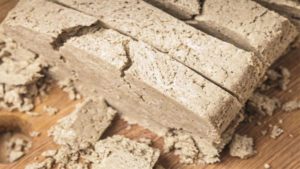
What is tahini halva made of
The recipe for making a tahini delicacy is known only to specialists in the production of oriental sweets, and it is kept secret. It is for this reason that the taste of the finished product and its beneficial properties vary from country to country.
For example, some specialists mix all the necessary ingredients by hand and do not recognize any other method. It is believed that this is the only way oriental sesame sweets acquire airiness and unique taste.
The main ingredients are:
- sesame protein mass;
- honey;
- granulated sugar;
- syrup;
- foaming agent.
It would seem that cooking on your own is not so difficult, you just need to mix all the ingredients and put the mass for a while under a press, but not everything is so simple. Mixing all the ingredients is an art, in the process of which it is customary to adhere to secret technologies.
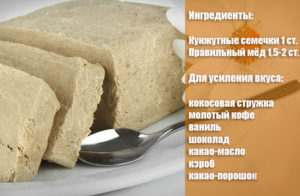
Composition and calorie content of sesame halva
If we consider the composition and useful properties of sesame halva, then it is worth noting that the original delicacy cannot be compared with anything else. In addition to taste, the product is also rich in biochemical composition.
For every 100 g, there are about 510 kcal. Such a rich energy composition was obtained thanks to:
- proteins - 13 g;
- fat - 30 g;
- carbohydrates - 51 g.
In addition to these elements, the finished product includes the following components, as a result of which the delicacy has the following useful properties:
- protein;
- magnesium;
- iron;
- calcium;
- sodium;
- phosphorus;
- zinc;
- potassium;
- copper;
- food acid.
Few sweets can boast of such a set of elements. That is why it is not recommended to get involved in halva, despite its beneficial properties, because it can cause significant harm to health.
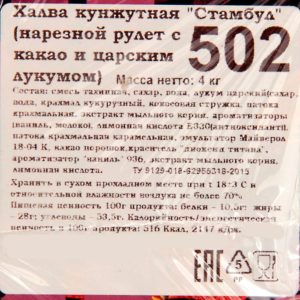
The benefits of sesame halva for the body
Before purchasing and starting to use takhin halva, the benefits and harm to the body are taken into account in advance. If you use the product regularly and in an acceptable amount, then you can count on the following:
- due to the large amount of fatty acids, lipid metabolism improves, which prevents the accumulation of cholesterol;
- if you eat up to 20 g of the product daily, the body will be completely saturated with micro- and macroelements necessary for normal functioning;
- prevents iron deficiency in the body;
- vitamins of groups A, B and E have a beneficial effect on the functioning of the body.
Takhinny sweetness is able to replace chocolate and lift the mood, relieve depression.
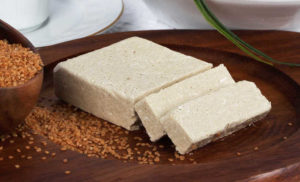
Is it possible to sesame halva
Just like sesame, tahini-peanut halva is able to bring both benefits and harm to the human body in equal measure. Before you start eating this product, you should understand that it is high in calories. Among the main components that are included in the composition are:
- nuts;
- sesame;
- sunflower seeds.
On the one hand, the product is capable of causing a strong allergic reaction, and on the other, due to its properties, it can be very useful for the body. Since a sesame delicacy is a rather complex product that can cause a disturbance in the digestive system not only in adults, but also in children, it must be used extremely carefully.
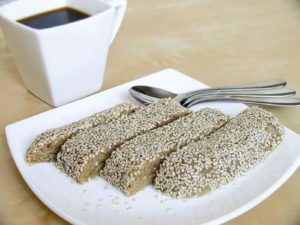
For pregnant women
You should always consider the benefits and harms of sesame halva for a woman in position. As a rule, the daily intake is about 50 g. In the early stages of pregnancy, a woman can afford the same amount of the product. It should be borne in mind that gradually the consumption of sesame delicacies should be reduced, as a result of which, in the last months of pregnancy, it should be completely excluded from the diet.
Since this product is high in calories, there is a chance of gaining excess weight. If you do not give up treats in the last stages of pregnancy, then in a newborn this can provoke an allergic reaction to the components that make up the composition.
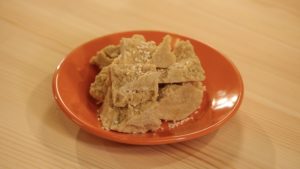
Nursing mothers
Undoubtedly, sesame halva is beneficial for a woman during lactation. It is recommended to consume the product in small portions, while it is necessary to observe the reaction of the newborn. If you use this product during lactation, it will have a beneficial effect on the fat content of breast milk.
Thanks to its beneficial properties, sesame halva is able to help a woman recover after childbirth, improve her mood, and prevent postpartum depression. Also, such a delicacy allows the child to grow and develop faster due to the large amount of vitamins.
The invaluable and useful properties include:
- allows you to significantly improve the condition of a woman with anemia;
- promotes blood purification;
- has a beneficial effect on the digestive system;
- increases the level of efficiency;
- allows you to get rid of a depressive state.
Thanks to the high content of amino acids and proteins, it promotes health and mental alertness.
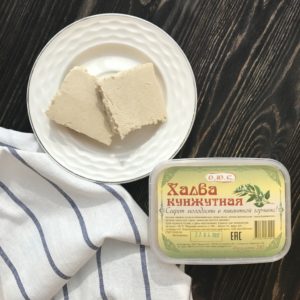
For children
Many parents begin to introduce halva into the child's diet from the age of 2. Pediatricians advise not to rush, because the product can easily get stuck in the teeth, thereby bringing harm to the child, and not the benefits that parents expect. In addition to the appearance of caries, there is a possibility that the child will simply choke.
The optimal age is 6 years. During this period, you can give the child about 5-10 g of treats, while it is necessary to monitor his reaction. If an allergic reaction does not appear, then it can be gradually increased to 30 g. It is recommended to use halva for children no more than 3 times a week. In any case, before starting to introduce a new product into the child's diet, you must first consult a pediatrician. This approach will bring health benefits and eliminate the risk of harm.
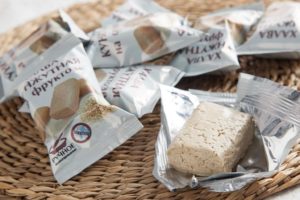
Recipe for making homemade sesame halva
Preparing sesame halva yourself at home, although problematic, is possible. The cooking method is as follows:
- You need to take 2 tbsp.sesame seeds and flour, 200 g sugar, 100 ml milk, 6 tbsp. l. vegetable oil and vanilla sugar (small amount).
- Sesame seeds are fried in a hot frying pan without adding vegetable oil until golden brown. Roasted sesame seeds can be purchased if necessary, but the price will be much higher.
- The roasted seeds are placed in a blender.
- They begin to fry the flour.
- Sugar is added to milk and syrup is boiled.
- Sesame is ground to an oily mass and then mixed with flour, butter and syrup.
- After that, you need to knead the mass, make it homogeneous, give it any shape and allow it to cool at room temperature.
As a flavor enhancer, you can add coconut, chopped nuts, poppy seeds, cocoa.
Harm of sesame halva and contraindications
Sesame-peanut halva brings not only benefits, but also harm, because in some cases you can observe side effects if you abuse this product. Before use, it is recommended to consider a number of important points:
- most often, an allergic reaction is observed to sesame and soap root, therefore, before starting to use the product, it is necessary to consult a specialist, since there is a high probability of causing harm to health;
- tahini products can cause diathesis in children due to the high sugar content;
- sesame halva is high in calories, due to its high content of fats and carbohydrates;
- product abuse can cause increased metabolism.
If you ignore these nuances, then the product can be harmful to health, for example, cause a persistent allergic reaction, promote rapid weight gain.
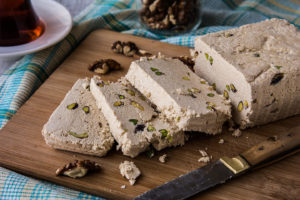
How to choose sesame halva
Considering that sesame halva benefits and harms the human body, then it is necessary to choose the right product with preserved beneficial properties. Before buying, you should adhere to some recommendations:
- since halva does not tolerate sunlight, the packaging must be airtight and made of foil;
- if oil is visible on the surface of the product, this indicates that production technologies have been violated;
- when cutting, the shape is preserved, crumbling is not observed;
- complete absence of hard caramel streaks. If they are, then the technology is broken;
- the cut is even.
If you choose a product carefully, then you can buy really high-quality and healthy sesame halva, which will not harm the body if you eat it wisely.
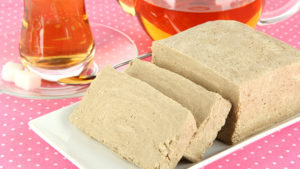
Storing sesame halva
The shelf life should not exceed 6 months. As a rule, the finished product should be further stored after opening the package in the refrigerator.
Sesame halvah is sold in vacuum foil packaging. Tight-seal containers are ideal for further storage. Many housewives cut halva into small pieces, put it in a glass jar, close it tightly with a lid and store it in the refrigerator.
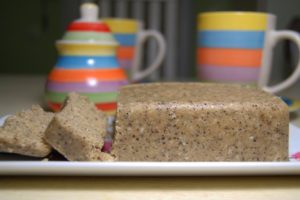
Conclusion
The benefits and harms of sesame halva, of course, should be considered before making a purchase. Undoubtedly, due to its properties, halva is a useful food product, but at the same time it should be eaten with extreme caution. You always need to consider the consequences and harm that can be done to the body. It is for this reason that it is recommended to initially seek the advice of a specialist and only after that introduce sesame sweetness into the diet.

